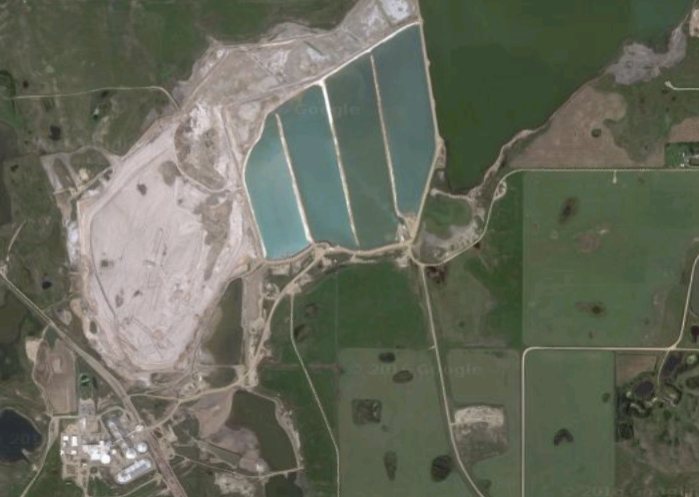Preparing for Climate Extremes at PotashCorp

Potash Corporation of Saskatchewan, the world's largest supplier of a key fertilizer ingredient, faces increasing threats to its mining operations from extreme climate events. Is the company's strategy to protect its workers and facilities sufficient?
The Potash Corporation of Saskatchewan (PotashCorp) feeds the world from five mines in the Canadian province of Saskatchewan. The company produces 20% of the world’s potash, a crucial ingredient in agricultural fertilizer. [1] Tied to Saskatchewan by the area’s mineral deposits, PotashCorp is faced with the need to mitigate the increasing frequency of extreme weather events in the province. But its efforts thus far underestimate its challenge.
Modern agriculture depends on the potassium-rich salts known as potash.[2] This need is growing steadily; the United Nations predicts demand for potash to increase 2.6% annually through 2018.[3] This increase in demand will be met largely by four countries, which together account for 69% of world reserves and 75% of world production: Canada, Russia, Belarus, and China.
Exhibit 1: Potash Industry Geographic Breakdown
This combination of global demand and concentrated supply means that disruptions to operations at PotashCorp – the world’s largest potash supplier – could increase food costs worldwide.[4]
Saskatchewan experiences some of the largest variability in precipitation and temperature in Canada.[5] That variability has increased further in recent years. Researchers predict increasingly frequent excessive moisture and flooding events, extreme weather events, and water scarcity.[6] Each item poses its own threats to PotashCorp’s mining operations:
- Excessive moisture and flooding threatens PotashCorp facilities and increases the volume of brine that the company must manage[7]. In particular, flooding and high levels of precipitation raise the levels of tailing ponds[8], straining secondary containment systems and water treatment budgets.[9]
- Extreme weather (e.g. heavy precipitation and high winds) pose risks to tailing ponds similar to those posed by flooding. In addition, these events threaten infrastructure damage and introduce health and safety concerns for workers in mining locations.[10]
- Water scarcity is an existential threat to potash mining, for which water is an essential resource.[11] A disruption to the source from which a PotashCorp mine draws its water could bring that operation to an immediate halt.[12]

Source: PotashCorp
The company is addressing the danger of flooding and extreme weather with proactive planning focused on emergency readiness. New emergency plans and drills stress responsiveness to fast-moving, short-term events (e.g. floods and tornados) at the level of the individual mine.[13]
To combat the dangers of flooding, PotashCorp is investing in infrastructure. New deep-injection wells facilitate brine disposal while new safe storage facilities can manage increased volumes of wastewater until it is ready for injection.[14] New flood water bypass and retention infrastructure directs floodwaters away from mine sites.[15]
Finally, PotashCorp is investing in water reuse and recycling programs, aiming to eliminate direct discharge of water (other than brine disposal) at its mine sites.[16]
Table 1: PotashCorp Climate Risk Mitigation Strategy Summary
These strategies for addressing climate risks have been effective to date. PotashCorp’s operations have experienced no significant interruption as Saskatchewan has swung from record rainfall in 2014 to record drought in 2015 to record rainfall again in 2016[17] Yet the company risks underestimating future problems.
PotashCorp’s efforts assume a future that will be consistent with the past. Emergency readiness plans at its sites are based around expectations of a “one-in-a-century” event, failing to realize that climate change will change the meaning of that term. Nor does the company make mention of the compounding threat of multiple floods in back-to-back periods, which are more dangerous than single-year events. Finally, PotashCorp’s water efficiency efforts take for granted access to water sources. Other companies are making no such assumptions; Western Potash, a smaller competitor, signed a 40-year contract in 2014 to purchase wastewater from the City of Regina as a hedge against drought.[18]
There may be good reason for PotashCorp’s apparent shortsightedness: Its efforts to mitigate climate risk been successful thus far and it is in the midst of an attempted merger with Agrium, an important competitor.[19] Nonetheless, the company would benefit from a more robust strategy built around expecting the unexpected.[20] It must prepare for events that exceed what it can predict.

Source: Google Maps
Better preparation will begin with water strategy. No amount of water efficiency improvement can change the fact that – due to brine disposal – potash mining requires constant water inputs. Although the company has to date not experienced water scarcity, it should actively seek innovative and alternative water sources.
At the other end of the water cycle, PotashCorp should rethink its tailing pond strategies. Instead of trying to build containment systems stronger than nature, the company should focus on finding ways to increase the rate at which it can move wastewater from mine to injection site.
Finally, PotashCorp should develop emergency plans at its sites that think beyond one-in-a-century storms and focus on giving site management the resources and training to address extreme events that surpass what has been planned for.
PotashCorp has thrived for decades thanks to the potassium-rich remains of Saskatchewan’s ancient climate. To continue to thrive, it must embrace the uncertainty of Saskatchewan’s future climate, taking a longer-term view of risks in the process.
Exhibit 2: PotashCorp Financial Summary
[1] Substances like manure and glauconite (also known as greensand) are far lower in potassium than potash and far more difficult and expensive to transport. (U.S. Geological Survey, “Mineral Commodity Summaries,” January 2015, accessed at http://minerals.usgs.gov/minerals/pubs/commodity/potash/mcs-2016-potas.pdf on October 31, 2016.)
[2] Potash is a $23 billion global industry, with almost every single country importing the material. (“Fertilizer Manufacturing in the U.S.,” IBISWorld Industry Reports, March 2016, accessed through Harvard Baker Library on November 3, 2016.) 90% of PotashCorp’s production is exported, largely to Asia, Europe, and Latin America. (Potash Corporation of Saskatchewan, “2016 Third Quarter Quarterly Report on Form 10-Q,” accessed at http://www.potashcorp.com/library/securities_filings/ on November 1, 2016.)
[3] Food and Agriculture Organization of the United Nations, “World Fertilizer Trends and Outlook to 2018,” 2015, accessed at http://www.fao.org/3/a-i4324e.pdf on October 31, 2016.
[4] PotashCorp, “Five Whys and a How About PotashCorp,” accessed at http://www.potashcorp.com/media/POT_5Ws_brochure.pdf” on November 1, 2016.
[5] Duane Haave, “WUQWATR Climate Extremes Preparedness Workshop Final Report,” Saskatchewan Water Authority, March 5, 2012, accessed at http://www.adaptationlibrary.ca/wp-content/uploads/adaptation_library/117_PR_WUQWATR_Climate_Extremes_Workshop_Final_Report_March_2012.pdf on October 31, 2016.
[6] Elaine Wheaton, Changing Risks of Wet and Dry Extremes in Saskatchewan, Canada, 2013, accessed at http://link.springer.com/article/10.1007/s11069-016-2190-7 on November 2, 2016.
[7] Potash brine is a mixture of salt and water used in potash mining. In certain forms of potash mining, the heated mixture is pumped into potash deposits, where potash dissolves into the brine. The potash-rich brine is then pumped back to the surface. Strict regulations dictate the storage and disposal of brine. (Carlos Perucca, “Potash Processing in Saskatchewan: A Review of Process Technologies,” CIM Bulletin 96.1070 (2003): 61-65, accessed at http://citeseerx.ist.psu.edu/viewdoc/download?doi=10.1.1.590.6500&rep=rep1&type=pdf on November 1, 2016.
[8] A tailing pond is a repository for waterborne refuse (e.g. potash brine) left over after it has been used in the mining process. This refuse material is pumped into the tailing pond to allow the solids it contains to separate from the water.
[9] Interview by the author of Brent Kunkle, Sustainability Manager at PotashCorp, conducted by telephone on November 1, 2016.
[10] F.J. Warren and D.S. Lemmen (editors), Canada in a Changing Climate: Sector Perspectives on Impacts and Adaptation, Government of Canada, 2014, accessed at http://www.nrcan.gc.ca/sites/www.nrcan.gc.ca/files/earthsciences/pdf/assess/2014/pdf/Full-Report_Eng.pdf on October 31, 2016.
[11] Water is used in both extracting and milling potash. The use of water in extraction was described in footnote 7. Following extraction, water is used throughout the milling process, from flotation to drying and sizing. Finally, water is used in tailing disposal, as brine is injected underground.
[12] J. Pittman, T. Pearce, and J. Ford, “Adaptation to Climate Change and Potash Mining in Saskatchewan: Case Study from the Qu’Appelle River Watershed,” Natural Resources Canada Climate Change Impacts and Adaptation Division, 2013, accessed online at http://www.arctic-north.com/wp-content/uploads/2012/09/saskatchewan_web.pdf on November 1, 2016.
[13] Interview with Kunkle.
[14] Deep-injection wells allow for the disposal of brine by injecting it into preexisting saline aquifers. The process is effective but slow, hence the increase in wastewater levels even as new wells are added. Safe storage facilities take the form of perimeter dykes, ditches, and berms around brine ponds, which can absorb increasing volume. (Pittman, Pearce, and Ford, 2013.)
[15] Floodwater bypasses direct excess surface water away from mine sites. Retention ponds slow the flow of water around a mine site, dampening downstream flooding potential. (Ibid)
[16] The company does not disclose specifics of its efforts in this realm. Other companies reveal strategies like using excess water from tailing ponds for their milling process.
[17] Meaghan Craig, “Drier than the Desert, Saskatoon’s Lack of Rainfall Breaks Records,” Global News, July 13, 2015, accessed at http://globalnews.ca/news/2108403/drier-than-the-desert-saskatoons-lack-of-rainfall-breaks-records/ on November 2, 2016 and Davis Giles and Thomas Piller, “Aborfield issues evacuation order as breach gives way to approaching floodwaters,” Global News, July 12, 2016, accessed at http://globalnews.ca/news/2819760/carrot-river-arborfield-declare-local-states-of-emergency/ on November 2, 2016.
[18] “Western Potash finalizes $200M Deal to Buy Treated Sewage from City of Regina,” CTV News Regina, accessed at http://regina.ctvnews.ca/western-potash-finalizes-200m-deal-to-buy-treated-sewage-from-city-of-regina-1.1057102 on November 2, 2016.
[19] Jen Skerritt and Simon Casey, “PotashCorp and Agrium to Merge, Creating Fertilizer Giant,” Bloomberg Markets, September 12, 2016, accessed at http://www.bloomberg.com/news/articles/2016-09-12/agrium-potash-corp-to-combine-in-fertilizer-merger-of-equals on November 3, 2016.
[20] The company is not always quick to react even to the expected. Its response to climate change-inspired government regulation suffers from myopia. In the past year both the governments of Canada and of Saskatchewan have announced plans to institute carbon taxes, which would likely have major effects on the mining sector. PotashCorp has taken no action in response other than acknowledgement that it is aware legislators are proposing the new taxes. (Potash Corporation of Saskatchewan, “2016 Third Quarter Quarterly Report on Form 10-Q.”)



MDLB, I appreciate the opportunity to consider your very thoughtful post on something I had never heard about until last week. Props to you for finding such an obscure but entirely relevant topic for this assignment. Bravo.
Would increased rainwater really require more preparation from PotashCorp. Judging by the aerial photo above, it looks like there is plenty of room for additional tailing ponds that could be used to manage a surplus of additional rainwater that may result from climate change. I agree with your assessment that the strategy should be to inject water into the potash mine as rapidly as possible without causing damage to the resource but it seems like water handling capacity would reduce the need to change operations on account of the changing climate.
Very interesting subject! I agree with the comment above that tailing ponds seems to be an effective solution to manage excess water. To better prepare for severe weather conditions, the company could also invest in sophisticated predictive tools to estimate the amount of water required in the tailing ponds. You also mentioned that Western Potash signed a contract to purchase wastewater from the City of Regina as a hedge against drought, I wonder if PotashCorp could also hedge for climate change risk. For example, the Company could perhaps invest in research for alternative potassium fertilizer, where geographic area is not as important. This may mitigate the risk of an extreme weather event because PotashCorp would still be able to produce potash in another area [1].
[1] http://news.mit.edu/2014/potash-historical-pathways-development-1205
Your post drives home just how pervasive the effects of climate change will be. When even resources like potash – which will be critical ingredients for ensuring sufficient food supply in an age of climate-stressed crops – are impacted by increased risks from climate change, we have to reckon with how vulnerable our entire food supply is to climate change. Thank you for calling attention to a little realized issue, and yet one more example of the scale of the challenges we face.